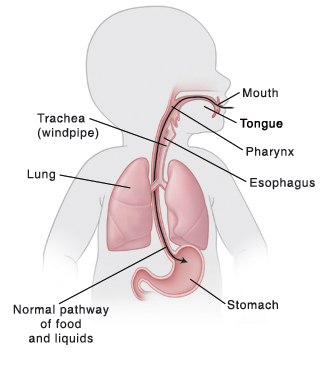When Your Child Has Dysphagia
When Your Child Has Dysphagia
Dysphagia is a condition in which your child has problems swallowing food or liquids. It often affects children who are just learning to eat solid foods. Dysphagia can make it hard for your child to get enough nutrients for good growth.
Normal swallowing
Food enters the mouth and is chewed. The tongue moves the chewed food to the back of the throat (pharynx). The food is then swallowed. It passes into the esophagus. The esophagus is the muscular tube leading to the stomach. The esophagus tightens and relaxes in wavelike motions to move swallowed food into the stomach.
What are the symptoms of dysphagia?
Common symptoms of dysphagia include:
Choking, coughing, or sputtering while eating or drinking
Poor suck
Fussiness or arching of the back
Drooling
Noisy breathing
Not gaining weight
Child can't coordinate chewing and swallowing, or refuses food or takes a very long time to eat
Upper respiratory problems such as pneumonia, from food or drink being inhaled into the lungs (aspirated)
Occasional vomiting or regurgitation. Regurgitation is the flow of stomach contents and digestive acids back into the throat.
What causes dysphagia?
Dysphagia can be caused by any of the following:
Nerve or brain problems that affect control of muscles in the mouth, tongue, throat, or stomach
Other health problems that exist at the same time. These include prematurity, GI disorders, and congenital heart disease.
Problems with the shape of your child’s mouth, tongue, or throat
Thickening or narrowing of the esophagus (stricture)
How is dysphagia diagnosed?
To find out if your child has dysphagia, your healthcare provider may order some tests. He or she may refer you to a specialist who will help develop swallowing skills. One such test might be a swallow study. This test can help the healthcare provider learn more about your child's swallowing problem. The swallow test allows the healthcare provider to watch your child swallow a barium solution while this action is X-rayed. Occasionally, endoscopy is used to visualize your child's swallowing habits.
How is dysphagia treated?
Your child’s treatment will depend on where the problem is located and what is causing the problem. Treatment may include:
Therapy to help your child learn how to move food properly in the mouth
Medicine may be prescribed to reduce reflux
Insertion of a feeding tube (if the problem is severe and your child needs help getting nutrition)
Changes in diet (such as thickened foods that help your child chew more easily)
A procedure to widen the esophagus (if the esophagus is too narrow)
When to call the healthcare provider
Call the healthcare provider right away if you notice any of these problems:
Food seems to get stuck in child’s mouth or throat during feeding.
Child has difficulty breathing, or breathing stops during feeding.
Child’s skin or lips turn blue when feeding.
Updated:
January 20, 2018
Sources:
Evaluation of dysphagia in children. UpToDate
Reviewed By:
Adler, Liora C., MD,Bass, Pat F. III, MD, MPH
